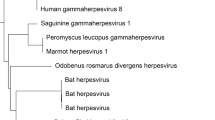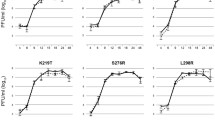Summary
The thymidine kinase (TK) of herpesviruses, in contrast to cellular TKs, phosphorylates a variety of substrates including antiherpetic nucleoside analogues. This study reports the identification and DNA sequence of the simian varicella virus (SVV) TK gene. A32P-labeled varicella zoster virus (VZV) TK DNA probe hybridized to the HindIII B subclone of the SVV BamHI B restriction endonuclease (RE) fragment, indicating the presence of a SVV DNA sequence homologous to the VZV TK gene. DNA sequence analysis of the SVV HindIII B subclone revealed a 1014 base pair (bp) open reading frame (ORF) encoding a 337 amino acid polypeptide homologous to herpesvirus TKs. The predicted SVV and VZV TK polypeptides share 51.3% identity, and alignment of the putative protein sequence of several TK homologues suggests the position of a conserved nucleotide binding site and a nucleoside (substrate) binding site in the SVV TK. Identification of the 5′ end of the SVV TK transcript by primer extension analysis allowed a comparison of the SVV and VZV TK promoter regions indicating extensive conservation of the DNA sequence and transcription factor binding sites. Plaque reduction assays demonstrate that the SVV TK is active based on the susceptibility of SVV to acyclovir treatment and that SVV is less sensitive to acyclovir than VZV and herpes simplex virus (HSV-1) in infected Vero cells. Identification of the SVV TK ORF will facilitate studies that examine the role of viral TKs in pathogenesis and antiviral sensitivity and provides a potential insertion site for the expression of foreign genes.
Similar content being viewed by others
References
Ayres JP (1971) Studies of the delta herpesvirus isolated from the patas monkey (Erythrocebus patas). Lab Anim Sci 21: 685–695
Balfour HH JR, McMonigal KA, Bean B (1983) Acyclovir therapy for varicella-zoster virus infections in immunocompromised patients. J Antimicrob Chemother 12 [Suppl B] 169–179
Balfour BB JR (1993) Current management of varicella zoster virus infections. J Med Virol [Suppl] 1: 74–81
Bean B, Aeppli D, Balfour HH JR, (1983) Acyclovir in shingles. J Antimicrob Chemother 12 [Suppl B]: 123–127
Boyd MR, Bacon TH, Sutton D (1988). Antiherpes activity of 9-(4-hydroxy-3-hydroxymethylbut-1-yl)guanine (BRL 39123) in animals. Antimicrob Agents Chemother 32: 358–363
Cabirac GF, Mahalingam R, Wellish M, Gilden DH (1990) Trans-activation of viral TK promoters by proteins encoded by varicella zoster virus open reading frames 61 and 62. Virus Res 15: 57–68
Clarke P, Rabkin SD, Inman MV, Mahalingam R, Cohrs R, Wellish M, Gilden DH (1992) Molecular analysis of simian varicella virus DNA. Virology 190: 597–605
Collins P (1983) The spectrum of antiviral activities of acyclovir in vitro and in vivo. J Antimicrob Chemother 12 [Suppl B]: 19–27
Darby G, Larder BA, Inglis MM (1986) Evidence that the “active centre” of the herpes simplex virus thymidine kinase involves an interaction between three distinct regions of the polypeptide. J Gen Virol 67: 753–758
Davison AJ, Scott JE (1986) The complete DNA sequence of varicella-zoster virus. J Gen Virol 67: 1759–1816
Devereux J, Haeberli P, Smithies O (1984) A comprehensive set of sequence analysis programs for the VAX. Nucleic Acids Res 12: 387–395
Ecker JR, Hyman RW (1982) Varicella zoster virus DNA exists as two isomers. Proc Natl Acad Sci USA 79: 156–160
Feng DF, Doolittle RF (1987) Progressive sequence alignment as a prerequisite to correct phylogenetic trees. J Mol Evol 25: 351–360
Fletcher TM, Gray WL (1993) DNA sequence and genetic organization of the unique short (Us) region of the simian varicella virus genome. Virology 193: 762–773
Fletcher TM, Gray WL (1992) Simian varicella virus: characterization of virion and infected cell polypeptides and the antigenic cross-reactivity with varicella-zoster virus. J Gen Virol 73: 1209–1215
Furman PA, St. Clair MH, Fyfe JA, Rideout JL, Keller PM, Elion GB (1979) Inhibition of herpes simplex virus-induced DNA polymerase activity and viral DNA replication by 9-(2-hydroxyethoxymethyl)guanine and its triphosphate. J Virol 32: 72–77
Furman PA, St. Clair MH, Spector T (1984) Acyclovir triphosphate is a suicide inactivator of the herpes simplex virus DNA polymerase. J Biol Chem 259: 9575–9579
Fyfe JA, Biron KK, McKee SA, Kelly CM, Elion GB, Soike KF (1982) Activation and antiviral effect of acyclovir in cells infected with varicella-like simian virus. Am J Med 73: 58–61
Gentry GA (1985) Locating a nucleotide-binding site in the thymidine kinase of vaccinia virus and of herpes simplex virus by scoring triply aligned protein sequences. Proc Natl Acad Sci USA 82: 6815–6819
Gray WL, Baumann RP, Robertson AT, Caughman GB, O'Callaghan DJ, Staczek J (1987) Regulation of equine herpesvirus gene expression: characterization of immediate early, early, and late transcription. Virology 158: 79–87
Gray WL, Pumphery CY, Ruyechan WT, Fletcher TM (1992) The simian varicella virus and varicella zoster virus genomes are similar in size and structure. Virology 186: 562–572
Gray WL, Oakes JE (1984) Simian varicella virus DNA shares homology with human varicella-zoster virus DNA. Virology 136: 241–246
Homa FL, Krikos A, Glorioso JC, Levine M (1991) Functional analysis of regulatory regions controlling strict late HSV gene expression. In: Wagner EK (ed) Herpesvirus transcription and its regulation. CRC Press, Boca Raton, pp 207–222
Kit S (1985) Thymidine kinase. Microbiol Sci 2: 369–375
Kozak M (1986) Point mutations define a sequence flanking the AUG initiator codon that modulates translation by eukaryotic ribosomes. Cell 44: 283–292
Liu Q, Summers WC (1988) Site-directed mutagenesis of a nucleotide-binding domain in HSV-1 thymidine kinase: effects on catalytic activity. Virology 163: 638–642
Lopetegui P, Matsunaga Y, Okuno T, Ogino T, Yamanishi K (1983) Expression of varicella-zoster virus-related antigens in biochemically transformed cells. J Gen Virol 64: 1181–1186
Lowe RS, Keller PM, Keech BJ, Davison AJ, Whang Y, Morgan AJ, Kieff E, Ellis RW (1987) Varicella-zoster virus as a live vaccine for the expression of foreign genes. Proc Natl Acad Sci USA 84: 3896–3900
McGeoch DJ, Cook S (1994) Molecular phylogeny of the alphaherpesvirinae subfamily and a proposed evolutionary timescale. J Mol Biol 238: 9–22
McKnight SL, Gavis ER, Kingbury R (1981) Analysis of transcriptional regulatory signals of the HSV thymidine kinase gene: identification of an upstream control region. Cell 25: 385–398
Needleman SB, Wunsch CD (1970) A general method applicable to the search for similarities in the amino acid sequence of two proteins. Proc Natl Acad Sci USA 48: 443–453
Oakes JE, d'Offay JM (1988) Simian varicella virus. In: Darai G. (ed) Virus diseases in laboratory and captive animals. Martinus Nijhoff, Boston, pp 163–174
Otsuka H, Kit S (1984) Nucleotide sequence of the marmoset herpesvirus thymidine kinase gene and predicted amino acid sequence of thymidine kinase polypeptide. Virology 135: 316–330
Prieto J, Martin-Hernandez AM, Tabares E (1991) Loss of pseudorabies virus thymidine kinase activity due to a single base mutation and amino acid substitution. J Gen Virol 72: 1435–1439
Pumphrey CY, Gray WL (1992) The genomes of simian varicella virus and varicella zoster virus are colinear. Virus Res 26: 255–266
Pumphrey CY, Gray WL (1995) DNA sequence of the simian varicella virus (SVV) gH gene and analysis of the SVV and varicella zoster virus gH transcripts. Virus Res 38: 55–70
Roberts GB, Fyfe JA, Gaillard RK, Short SA (1991) Mutant varicella-zoster virus thymidine kinase: correlation of clinical resistance and enzyme impairment. J Virol 65: 6407–6413
Robertson GR, Whalley JM (1988) Evolution of the herpes thymidine kinase: identification and comparison of the equine herpesvirus 1 thymidine kinase reveals similarity to a cell-encoded thymidylate kinase. Nucleic Acids Res 16: 11303–11317
Sanger F, Nicklen S, Coulson AR (1977) DNA sequencing with chain-terminating inhibitors. Proc Natl Acad Sci USA 74: 5463–5467
Sawyer MH, Inchauspe G, Biron KK, Waters DJ, Straus SE, Ostrove JM (1988) Molecular analysis of the pyrimidine deoxyribonucleoside kinase gene of wild-type and acyclovir-resistant strains of varicella-zoster virus. J Gen Virol 69: 2585–2593
Shiraki K, Hayakawa Y, Mori H, Namazue J, Takamizawa A, Yoshida I, Yamanishi K, Takahashi M (1991) Development of immunogenic recombinant Oka varicella vaccine expressing hepatitis B virus surface antigen. J Gen Virol 72: 1393–1399
Soike KF (1992) Simian varicella virus infection in African and Asian monkeys. The potential for development of antivirals for animal diseases. Ann NY Acad Sci 653: 323–333
Soike KF, Gerone PJ (1982) Acyclovir in the treatment of simian varicella virus infection of the African green monkey. Am J Med 73: 112–117
Soike KF, Felsenfeld AD, Gerone PJ (1981) Acyclovir treatment of experimental simian varicella infection of monkeys. Antimicrob Agents Chemother 20: 291–297
Staden R (1980) A new computer method for the storage and manipulation of DNA gel reading data. Nucleic Acids Res 8: 3673–3694
Suzutani T, Lacey SF, Powell KL, Purifoy DJM, Honess RW (1992) Random mutagenesis of the thymidine kinase gene of varicella-zoster virus. J Virol 66: 2118–2124
Talarico CL, Phelps WC, Biron KK (1993) Analysis of the thymidine kinase genes from acyclovir-resistant mutants of varicella-zoster virus isolated from patients with AIDS. J Virol 67: 1024–1033
Tenser RB (1991) Role of herpes simplex virus thymidine kinase expression in viral pathogenesis and latency. Intervirology 32: 76–92
Author information
Authors and Affiliations
Rights and permissions
About this article
Cite this article
Pumphrey, C.Y., Gray, W.L. Identification and analysis of the simian varicella virus thymidine kinase gene. Archives of Virology 141, 43–55 (1996). https://doi.org/10.1007/BF01718587
Received:
Accepted:
Issue Date:
DOI: https://doi.org/10.1007/BF01718587




